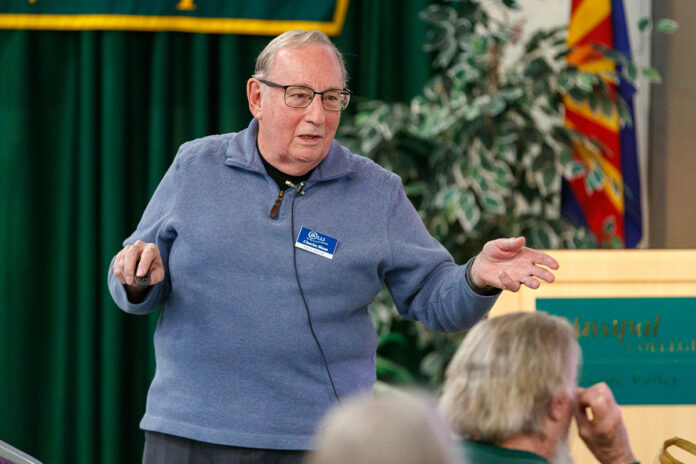Charles Blum presented “12 Things Americans Ought to Know About Mexican History” as part of the Osher Lifelong Learning Institute’s Brown Bag program at Yavapai College on Oct. 31.
Blum is a former diplomat and trade negotiator who described himself as having a long-standing fascination with Mexican history.
Blum began his presentation by discussing the mythological imagery of the Mexican flag, which depicts an eagle with a snake sitting atop a cactus on a body of water.
In Aztec legend, the god Huitzilopochtli instructed the people to settle down at the site where they observed this portent, which led to the foundation of Tenochtitlan in 1325.
Tenochtitlan was a developed city with specialized districts separated by canals. At its peak, its population was around 200,000, which was the largest in the Americas at that time. Blum stated that the entire population of North America at the time was possibly around 2 million, meaning that about 10% of the continent’s population lived in Tenochtitlan’s five square miles.
Mexico’s first university, which is now known as the National Autonomous University of Mexico, was founded in 1551. By the time the eight Ivy League schools were founded in the United States, UNAM was over 300 years old.
Mexico’s independence day is celebrated on Sept. 16 and involves festivities across the country. It commemorates the Mexican fight for independence from Spain launched in 1810 by the priest Miguel Hidalgo y Costilla, who became known as the father of Mexican independence after delivering his famous “Grito de Dolores” speech. Blum noted that unlike the founding fathers of the U.S., the founding fathers of Mexico were all killed.
The first ruler of independent Mexico was Emperor Agustin I, a military chief of the conservative faction who wanted to preserve the union with Spain and a monarchy of some sort. His reign lasted for 10 months before he fled to Spain. He returned to Mexico in 1824, where he was arrested and executed.
America’s first diplomatic representative in independent Mexico, Joel Poinsett, was later expelled from the country. Besides being a diplomat, Poinsett was also a botanist, a Secretary of War and a cofounder of the Smithsonian Institution. He was first sent to Mexico in 1822 and signed the first U.S.-Mexico treaty, the Treaty of Limits. After meddling in politics and promoting Freemasonry, Poinsett was declared persona non grata in Mexico in 1829.
Mexico abolished slavery in 1837 and declined to return runaways, refusing to cooperate with fugitive slave laws of the United States. Some routes on the Underground Railroad went through Texas to Mexican territory. This created tensions with the Mexican territory of Texas, leading to a revolt by American immigrants and the formation of the Lone Star Republic, and eventually contributing to the Mexican-American War.
Mexico lost 55% of its territory to the U.S. through various treaties, including the Treaty of Guadalupe Hidalgo that ended the Mexican-American War and gave land to the U.S. in 1848 and the Gadsden Purchase in 1853, through which the U.S. bought the area south of the Gila River in modern-day Arizona.
Blum clarified that Cinco de Mayo is not actually a Mexican holiday, but an American one, and showed pictures taken on May 5 in San Antonio, Texas, which were full of festivities, and on May 5 in Mexico, where everyday life was taking place.
Following the abdication of Agustin I, 25 presidents ruled Mexico between 1824 and 1857.
Mexico was weak and unstable while indebted to France, Spain and England. The Battle of Puebla was fought on May 5, 1862, between Mexicans and French forces sent by Napoleon III to create a satellite state in Mexico. The French lost significantly more men than Mexico and the battle became a point of pride for the Mexican people, as it was the first major French loss since the Napoleonic wars. While not a national holiday in Mexico, it is a recognized holiday in the state of Pueblo.
Blum said that the real revolution in Mexico started in 1910, following the administration of Porfirio Diaz, a military hero from the Battle of Puebla who served seven terms as president and promoted education and infrastructure while welcoming foreign investment. However, he enforced political repression and was exiled after the fraudulent election of 1910.
Franciso Madero then became president before being assassinated. Other figures in the revolution included Emiliano Zapata, who led the Madero revolt, and Pancho Villa, a popular hero who resisted the U.S. and attacked Nogales.
Three Mexicans have won a Nobel Prize. Alfonso Garcia Robles won the Nobel Peace Prize in 1982 for promoting nuclear disarmament in Latin America. Octavio Paz, known for his book “The Labyrinth of Solitude,” won the 1990 Nobel Prize for Literature. Mario Jose Molina Henriquez won the Nobel Prize in Chemistry in 1995 after uncovering chemical processes that depleted the ozone layer. His work led to the Montreal Protocol that helped phase out CFC chemicals found in household appliances such as refrigerators and air conditioners.
Blum concluded the lecture with a prediction that the next president of Mexico will likely be one of two women, Claudia Sheinbaum or Xochitl Galvez, following the 2024 election.



